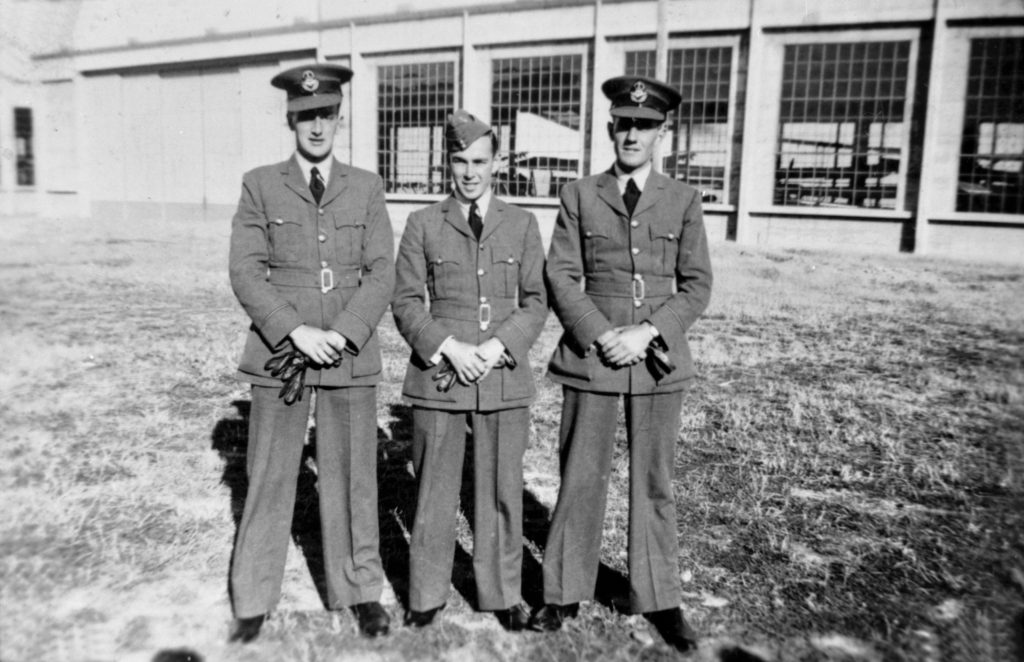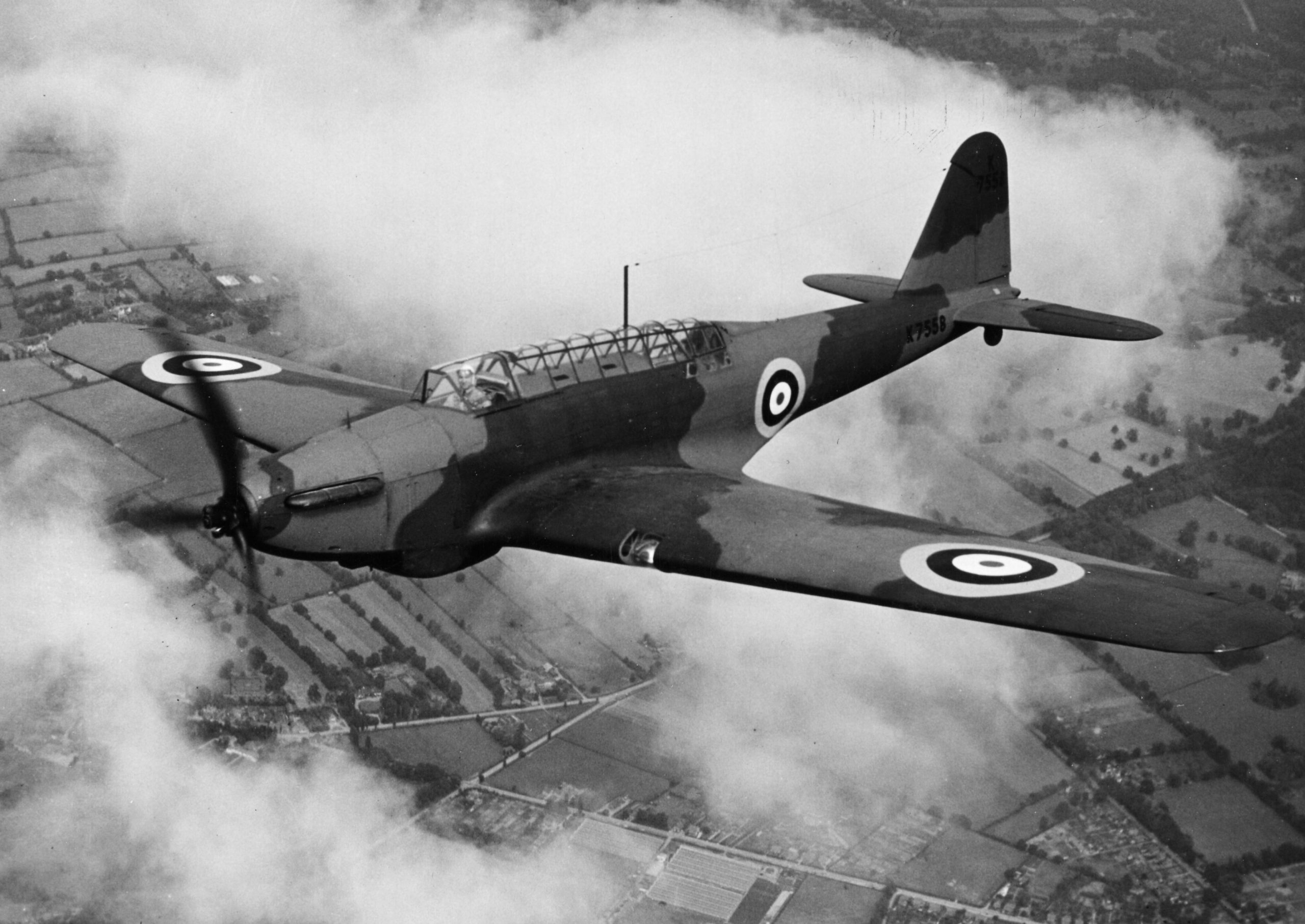In 1948, Flight Lieutenant W. Ian Anstey DFC replied to a letter he had received from Wing Commander H.L Thompson the previous year. Thompson was gathering accounts of the experiences of New Zealanders serving with or attached to the Royal Air Force (RAF) during World War Two for the Official History. This remarkable account survives in our archives and is one of the few surviving accounts of those desperate weeks of fighting by a New Zealand pilot.
Outnumbered and outclassed, Fairey Battle bombers made near suicidal attacks on the advancing Germans after several months of near peace. This is Ian Anstey’s story in his own words:

Arriving in France
“In company with about 20 complete flying crews which included V.A. Cunningham, J.C.F. Hayter, A.E. Wickham and self we left England on 27/11/1939 to join various RAF Battle Squadrons attached to the Advanced Air Striking Force stationed in France. We crossed to Cherbourg by ship and from there to Rheims by train. The most vivid memories of the train journey which was done at night were the great number of times we were shunted off on side lines – the rough coupling and uncoupling and stopping and staring of the French trains. I still think today that it was our engine driver’s first solo – and the amount of champagne which we all drank with many varied results. We arrived at Rheims somewhat the worse for wear on beer and champagne on the 29/11/39 and were sent off to our various squadrons which were grouped around the lovely old city.
I was sent to 218 Squadron situated at Auberive where I found another New Zealander, Ian Richmond. We were billeted in Auberive village about a mile from the aerodrome. The Mess was a storeroom over the local grocery come restaurant /shop. I slept in the attic of a farmer’s house on the outskirts of the village.”
The ‘Phoney War’
“From 29/11/39 to 12/5/40 we spent our time on operational training flights and censoring other ranks’ letters Life on the whole was rather dull and monotonous, an anticlimax to the declaration of war. Previous to my arrival in France, the Battle squadrons had attempted to carry out photographic recco of the Siegfried Line but the losses had been greater than the success of the missions so all operational sorties during this time were confined to No. 1 and No. 73 fighter squadrons and two or three Blenheim squadrons. Their combat reports were carefully read and digested and although we realised that our rather out of date Fairey Battles were not as good as the German aircraft. We carefully trained and developed ways of attack which we were confident would be successful when the time came. I would stress that at all times the morale of the Battle Squadrons from the flying crew down to the lowest ‘AC2’ was exceptionally high.
“Interesting diversions during the period were 10 days leave in England – once a month trip into Rheims for a luxurious bath, meal and drinks – a squadron move down to 1 Armament Training School at Perpignan near the Spanish border on the Mediterranean coast from 7/2/40 to 14/2/40 which involved a flight down the Rhone Valley and back up the Atlantic coast. A short course in gas spraying from the air which we did in England – also during this period the Squadron carried out a night leaflet raid over Germany. I was in isolation at the time recovering from a bout of German measles, but the rather amusing sequel to the raid was that two nights later the Jerries returned our visit and besides dropping a large number of German propaganda leaflets, they also returned a few hundred of our own leaflets which we had dropped on them.”

A ‘Valley of Hell’
“May 10th 1940 the balloon went up and the war began in real earnest. 11/5/40 H.H Murray another New Zealander who had just joined the Squadron a few days previously went out on his first operational trip – target (was) a German mechanised east of the Siegfried line and north of Aachen – he and the rest of the formation failed to return. I believe he was shot down when approaching the Siegfried Line.
12/5/40. Took off at 16.30 hrs on my first operations trip – target motor convoy passing through Bouillon north-east of Sedan – bomb load 4 250lb bombs. Flew in No. 2 position in a formation of 3 aircraft. We carried out the attack at about 100 feet. My first indication that we were over enemy territory was the sound of exploding shells followed almost immediately by seeing the roundel on the leader’s wing on which I was formateing as clearly as possible suddenly disappear leaving a gaping hole. A few seconds later smoke and flames began pouring from the leader’s engine and he passed under me in what appeared to be a shallow controlled dive, his gunner wireless operator giving the “thumbs up” sign. A few minutes later the convoy was sighted. No. 3 aircraft dropped his bombs and was last seen still continuing on his course behind the enemy lines. We dropped our bombs, but we were unable to observe results as the machine gun and pom pom-fire was becoming too intense and accurate. On our way back we passed over the burning wreckage of our leader’s aircraft. By now we were on our own and receiving the whole undivided attention of the enemy. We were flying at ground level and as we flew down the valley, we could see tracer bullets coming down from either side. I will remember to my dying day seeing two black and white cows peacefully grazing in the valley, as we zigzagged our way out of what seemed to us to be a valley of hell. Right then, I would have given anything to have been able to change places with the two old cows. After getting out of the valley in more or less one piece we crossed the front line and returned to base without further incident. Our ground crew met us with traditional open arms and after ascertaining that we were alright, that we had dropped our bombs and fired our guns and that the aircraft had flown alright, transferred their attention to the aircraft and proudly informed us that we had 72 bullet holes for our 15-minute joy ride over enemy territory.”
Epilogue
Ian Anstey was born in Timaru on 22 March 1919 and joined the RNZAF in 1938. He was granted a short-service commission in the RAF in 1939, before reverting back to the RNZAF in 1944 He survived two more missions in France with 218 Squadron before it was withdrawn. He later served in North Africa with the unit and later, No. 70 Squadron. In 1941, he was awarded the Distinguished Flying Cross (DFC). In all, he flew 70 missions in Battle, Blenheim and Wellington aircraft. The museum interviewed him in 2003. He died on 5 May 2004.





